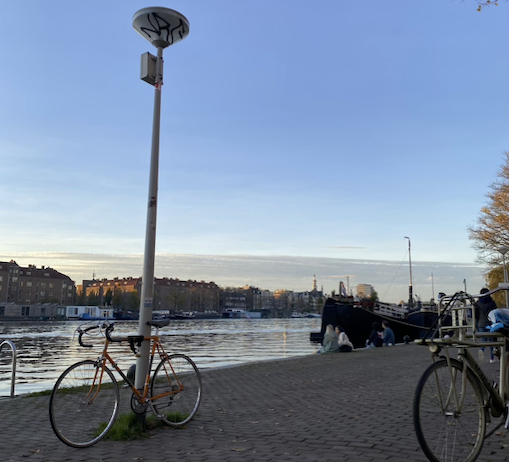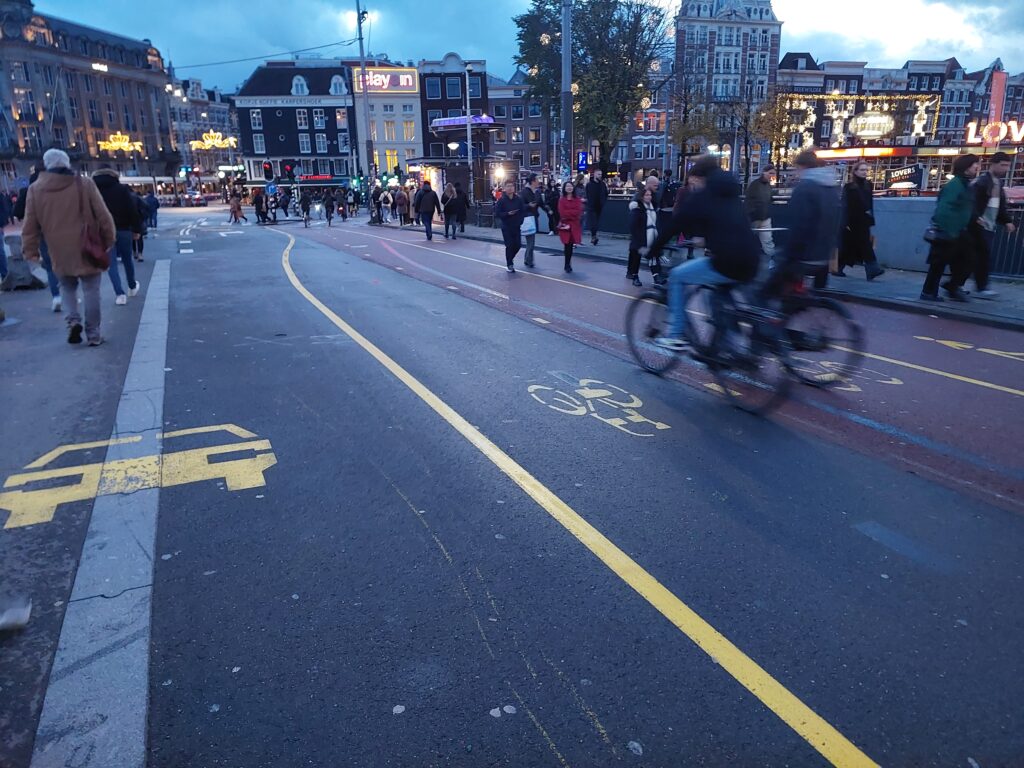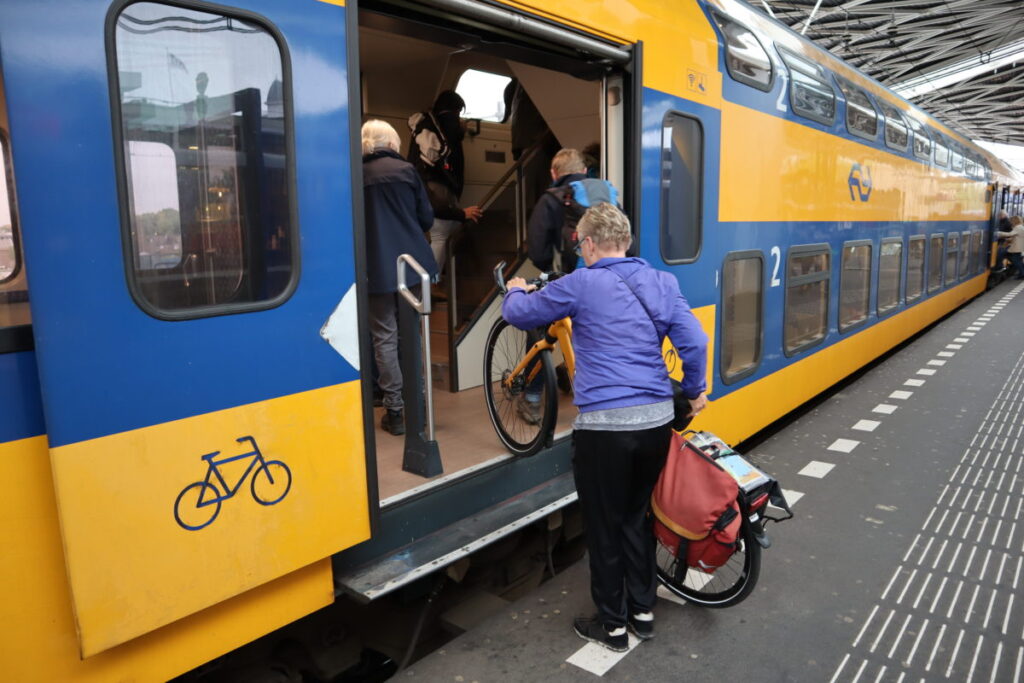Bram Nieuwstraten | LinkedIn
Selected final essay, published 10 September 2020
Policy Advisor at Vervoerregio Amsterdam Transport Authority
Unraveling the Cycling City MOOC on Coursera
In the Amsterdam suburbia, where urban planners could design roads (almost) from scratch from the 1960’s onward, all arteries were rigidly divided into main lanes and special lanes for cyclists. Planners believed this design would provide the optimum speed for cars, comfort for cyclists, and safety for both. The city of Amsterdam was not as easy to design in this fashion. Activists halted the planned grand transformation to cars, largely keeping the city the way it was for years to come. The city’s streets being neither particularly fast, comfortable, nor safe for all road users. Paradoxically, even though cycling is objectively better by all traditional measures in the suburbs, actual use and mode share percentages are higher in Amsterdam. I believe this paradox to be a consequence of the existence of special lanes for cyclists, which may be cursed in a way. As described by Swedish Engineer Einar Nordendahl in the 1930’s: “The construction of special lanes for bicyclists and pedestrians is to a large degree motivated by the urge to free the main lane from such traffic elements.” (Oldenziel & de la Brùheze, 2011). There has been a dogma ever since about the need to provide a main lane for cars, to let them operate at higher speeds.
Amsterdam planners have not been able to follow Mr. Nordendahl’s dogma the way they wanted, but have held onto it spiritually for quite some time. Only in the 2010s, the dogma was symbolically abandoned for the very first time, with the opening of the first Fietsstraat in the city of Amsterdam (a street designed as a bike lane, car users behave as good guests). In fact, Amsterdam was late, and is still lagging behind, even to its own suburbs, in the implementation of this concept. It seems somehow Amsterdam needs Fietsstraten less.

As described in Liu et al (2019), some Dutch transport practitioners believe that ‘deliberately branding’ infrastructure for cyclists will help foremost to get more funding and political backing. However, I argue this is not the case for Amsterdam. Because, what may present a political statement about the stimulating bicycle use elsewhere, is stating the obvious in Amsterdam. In reality, the Amsterdam Fietsstraat is more of a formalization. The main lane is not the exclusive domain of cars in many inner-city streets anyway, with high numbers of cyclists flocking in and out of the special lane, mingling among car traffic. This behaviour was not usually seen on the predecessors of suburban Fietsstraten. From my professional experience I can say ‘deliberately branded’ cycling infrastructure in the Amsterdam region is not necessarily being used significantly more, instead one can just as easily choose to mix with traffic on arteries with low car traffic volumes. I believe the matter of choice is the decisive factor. Because of the urban planning from scratch, cyclists in the Amsterdam suburbs usually have less choice, as they are confined to special lanes and routes.
Bertolini & Le Clerq (2003) present a new perspective on how the presence of cars is being handled in urban planning and how this may determine cycling. If the dogma of letting cars operate at higher speeds is discarded, no surplus space needs to be allotted to them, compared to cycling and walking. Instead, the degree of mixing and optimizing speeds for all modes is a central concept and feeds the following questions: When and why should we mix cyclists with pedestrians? When and why should we mix cyclists with cars? How strictly to enforce proper road position by cyclists? Are all cyclists equal in their need for speed?
Forsyth & Krizek (2011) propose that cyclists can be sorted into three classes, based on speed and skill, with each needing a slightly different network. Not all classes need a special lane, and the special lane does not cater to all classes. This way of thinking is almost completely alien to Dutch design practice. But it is reflected in the behaviour of some cyclists, as we do see them bending and breaking the rules every now and then. Speed cyclists believe the main lane is safer sometimes, because the speed differences between them and cars may be lower than compared to everyday cyclists. When gradual, non-compulsory design transitions – ranging from complete separation of all modes, some mixing of modes, to complete mixing of all modes – are applied, mobility choice will be gradual, depending on more than just habits and feelings of safety. A gradual design of cycling infrastructure has the best chance to attract users.
We may have to reconsider the prohibition of using both the main lane and the pavement, and the rigid implementation of special bikes lanes. My hypothesis is: The more cyclists are confined, the more the car will be chosen over the bike, no matter how good the cycling infrastructure may be. For a more balanced pattern of bicycle use across Amsterdam and its suburbs, I recommend planners in the latter partly end the confinement of cyclists and discuss the ‘main lane dogma’. More arteries should be planned with cyclists in mind, utilizing a mishmash of pavements, special lanes, and main roads. Only then a more balanced regional pattern of cycle use can emerge. Suburban municipalities are in fact contemplating some of these measures; however, especially Mr. Nordendahl’s dogma and the paradox of designing special lanes will probably prove hard to counter. Because it entails another Dutch dogma; that the special lanes always mean safety for all, and therefore should never be tampered with.

These dogmas are deeply ingrained in Dutch society, so abandoning them shall not be easy. The question rises, how we should do this, by urban planning, public discussion, or both? My hypothesis is that the way of urban planning will be most effective, especially when a communication strategy is applied, with the road design always messaging the desired behavior at every point. If the ending of mode confinement is applied in such a step-by-step-way, no hard political choices have to be made either. And, no real public outcry of law-abiding citizens fearing loss of safety will occur.
Sources:
- Bertolini, L., & le Clercq, F. (2003). Urban development without more mobility by car? Lessons from Amsterdam, a multimodal urban region.Environment and Planning A, 35(4), 575–589. https://doi.org/10.1068/a3592
- Forsyth, A., & Krizek, K. (2011). Urban Design: Is there a Distinctive View from the Bicycle? Journal of Urban Design, 16(4), 531–549. https://doi.org/10.1080/13574809.2011.586239
- Liu, G., te Brömmelstroet, M., Krishnamurthy, S., & van Wesemael, P. (2019). Practitioners’ perspective on user experience and design of cycle highways. Transportation Research Interdisciplinary Perspectives, 1, 100010. https://doi.org/10.1016/j.trip.2019.100010
- Oldenziel, R., & de la Bruhèze, A. A. (2011). Contested Spaces: Bicycle Lanes in Urban Europe, 1900–1995. Transfers, 1(2), 29–49. https://doi.org/10.3167/trans.2011.010203



